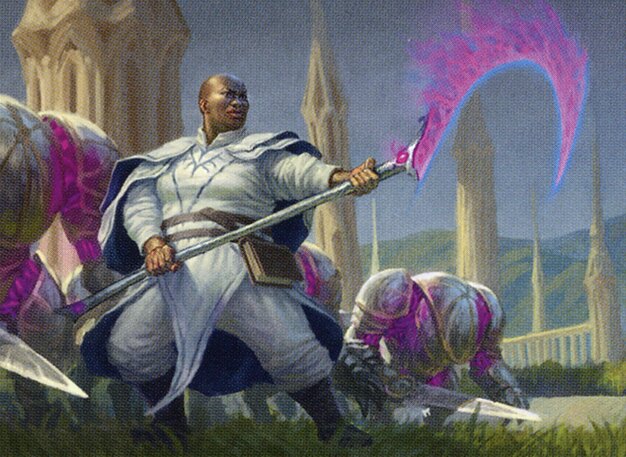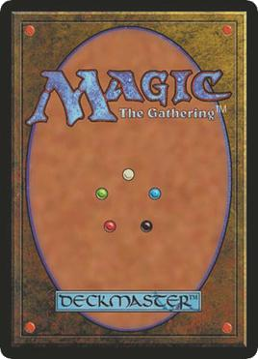 Art by Manuel Castañón
Art by Manuel CastañónPeasant = Only cards printed at common or uncommon. Also being printed at rare or mythic does not disqualify a common/uncommon card from selection.
Unpowered = Cards you are used to first-picking in a Vintage cube are not included, regardless of rarity.
This cube was derived and expanded from Emmmzyne's brilliant 450-card Peasant cube. The goal of most of the changes and additions was to increase synergy and reinforce the color-pair archetypes.
My favorite cube size below 720+ is 480 cards, which functions for these recommendations/allowances:
- 8-player draft with 3x 15-card packs
- 10-player draft with 3x 16-card packs, to improve wheel drafting
- 12-player draft, in two pods of six, with 3x 13-card packs
- 6-player sealed, with 80-card pools
Emmmzyne's breakdown is mostly copied below, accounting for card changes.

 AZORIUS
AZORIUS 

Azorius decks usually come in a few different flavors. Control decks tend to use Blue counter spells (Phantom Interference, Mana Leak, etc.) and card draw coupled with White removal to control the board and slow the opponent down, then win with a large creature. Aggro Azorius decks can use blink effects to save small creatures with enters triggers, keeping up the damage while gaining incremental advantage.

 DIMIR
DIMIR 

Dimir decks tend to focus on two avenues: Control and Midrange. Dimir Control decks differ from Azorius ones in that they tend to play fewer creatures and focus more on instant speed interaction and removal. Same can be said for Midrange, where sometimes you can loot away a big threat and reanimate it as part of a back-up plan.

 RAKDOS
RAKDOS 

Rakdos archetypes usually utilize sacrifice effects to gain advantage. They can also take more of a Midrange slant utilizing Black and Red removal spells to control the board. Sacrifice archetypes are very flexible in this cube, where you can draft Orzhov, Golgari, or light splashes for Jund or Mardu.

 GRUUL
GRUUL 

Gruul archetypes typically utilize mana acceleration to play bigger threats ahead of schedule, though you can also create an Aggro Gruul strategy. It tends to be slower compared to Boros Aggro, but trades speed for taller and more compelling threats enhanced by +1/+1 counters.

 SELESNYA
SELESNYA 

Selesnya leans hard into +1/+1 counters. Selesnya Aggro isn't as quick compared to Boros or even Gruul, but White can help push early damage with weenies, while Green goes wide and tall due to the use of tokens and +1/+1 counters. Midrange works too, with card advantage via Armorcraft Judge and enhancement from Outlast creatures.

 ORZHOV
ORZHOV 

Orzhov offers a solid sacrifice strategy, but also a Midrange-style build utilizing interaction and value cards such as Gonti, Lord of Luxury. Cards like Lingering Souls and Orzhov Enforcer are great in both.

 IZZET
IZZET 

Izzet tends to fall into a spellslinger-style strategy, which can lean into Control or Midrange. Similar to Dimir Control, Izzet Control uses Red removal and Blue countermagic to support the game plan. Blue also loves to take the opponent's permanents with effects such as Confiscate and Binding Grasp.

 GOLGARI
GOLGARI 

Golgari often falls into Midrange (aka "The Rock") where you utilize efficient Black removal and mana-efficient threats. Borrowing from other archetypes' strategies, Sacrifice and +1/+1 counters are also supported with signpost uncommons in Ravenous Squirrel or Winding Constrictor.

 BOROS
BOROS 

The most Aggro pairing in the cube is Boros, where the aim is to either go wide with tokens or simply curve-out with cheap and powerful threats, and finish with cards like Rally the Peasants or Sundering Eruption.

 SIMIC
SIMIC 

Simic often aims to leverage mana and card advantage to overwhelm the opponent. Simic ramp is a common strategy within this cube, where you use a mixture of bounce or bite interaction, Blue countermagic, and land ramp or mana dorks to cheat bigger threats ahead of schedule or out-tempo the opponent.


 OTHER ARCHETYPES
OTHER ARCHETYPES 


While not a primary archetype, there is a Blue Mill game plan that could serve as an alternative win condition for Control archetypes. Looting pairs nicely with the Mill cards, and helps to find them. Propaganda and other Tempo or Control cards can keep you alive, and could be perfect against Mono-Color decks.
And of course, Mono-Red Aggro is supported within the cube. Given the nature of the cube and how commons and uncommons don't always offer the best fixing, drafting a Mono-Color strategy is a solid approach if you want something streamlined.
Mono-White Aggro (also known as weenie) is also well-supported in the cube if you want to keep things aggressive, and can lightly splash for Boros cards such as Heroic Reinforcements or Frontier Warmonger, if needed. Also, you can draft Mono-Color strategies of each color, such as Mono-Blue Control and Mono-Green Ramp. Both Mono-Black Control and Mono-Black Aggro feature sacrifice and value effects.
There isn't a dedicated reanimator archetype in the cube even though there's a handful of reanimator spells. In many cases, these reanimator spells are for value and to serve as a secondary strategy to support your primary gameplan. I wouldn't recommend sitting down to draft this cube and force reanimator, because you are going to have a bad experience.
Notable Numbers
For fast preparation, here are some figures frequent cubers may find useful:
A. Creatures and creature token-makers
B. Average mana value for creatures and creature token-makers
C. Removal for creatures, including 2+ damage effects
D. Temporary creature control: bounce, tapping, and exiling that is bound to a creature
E. Enchantment removal
F. Artifact removal
| A | B | C | D | E | F | |||
|---|---|---|---|---|---|---|---|---|
| Crea. | Avg. | Remo. | Temp. | Ench. | Arti. | |||
  | 85 | 2.87 | 20 | 19 | 8 | 8 | ||
  | 73 | 3.11 | 30 | 15 | 2 | 0 | ||
  | 80 | 2.61 | 45 | 1 | 2 | 4 | ||
  | 88 | 2.93 | 28 | 2 | 6 | 10 | ||
  | 94 | 2.98 | 17 | 5 | 15 | 15 | ||
  | 87 | 2.67 | 35 | 4 | 11 | 8 | ||
  | 73 | 2.81 | 33 | 13 | 0 | 4 | ||
  | 87 | 3.15 | 27 | 1 | 10 | 8 | ||
  | 86 | 2.48 | 39 | 5 | 9 | 13 | ||
  | 84 | 3.42 | 11 | 14 | 6 | 6 | ||
 | 45 | 2.51 | 13 | 4 | 8 | 8 | ||
 | 32 | 3.31 | 7 | 13 | 0 | 0 | ||
 | 37 | 2.89 | 21 | 0 | 2 | 0 | ||
 | 37 | 2.32 | 23 | 1 | 0 | 4 | ||
 | 45 | 3.40 | 4 | 1 | 6 | 6 | ||
 | 14 | 5.00 | 2 | 4 | 2 | 2 |
The only infinite combos in the cube require Renata or Grumgully and Persist:
- Renata, Called to the Hunt OR Grumgully, the Generous + a sacrifice outlet...
- + Murderous Redcap = infinite damage
- + Kitchen Finks = infinite life
- + Putrid Goblin = infinite sacrifice/enters/dies triggers

